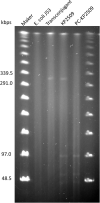Characterization of a mcr-1 and CRISPR-Cas System Co-harboring Plasmid in a Carbapenemase-Producing High-Risk ST11 Klebsiella pneumoniae Strain
- PMID: 34777318
- PMCID: PMC8579119
- DOI: 10.3389/fmicb.2021.762947
Characterization of a mcr-1 and CRISPR-Cas System Co-harboring Plasmid in a Carbapenemase-Producing High-Risk ST11 Klebsiella pneumoniae Strain
Abstract
We set out to study the prevalence of the mcr-1 gene in carbapenemase-producing Klebsiella pneumoniae (CPKP) strains, and to determine whether its presence is associated with a fitness cost. A total of 234 clinical CPKP isolates were collected from a tertiary medical center in Taiwan from January 2018 to January 2019. The mcr-1 and carbapenemase genes were detected by polymerase chain reaction (PCR) followed by Sanger sequencing. The mcr-1-positive carbapenemase-producing strain was characterized by whole genome sequencing, a plasmid stability test and a conjugation assay. In vitro growth rate and an in vivo virulence test were compared between the parental mcr-1-positive strain and its mcr-1 plasmid-cured strain. We identified only one mcr-1 positive strain (KP2509), co-harboring bla KPC- 2 and bla OXA- 48, among 234 (1/234, 0.43%) CPKP strains. KP2509 and its Escherichia coli mcr-1 transconjugant showed moderate colistin resistance (MIC = 8 mg/L). The mcr-1 is located on a large conjugative plasmid (317 kb), pKP2509-MCR, with three replicons, IncHI, IncFIB, and IncN. Interestingly, a complete Type IV-A3 CRISPR-Cas system was identified in pKP2509-MCR. Plasmid pKP2509-MCR was highly stable in KP2509 after 270 generation of passage, and the pKP2509-MCR cured strain PC-KP2509 showed similar growth rate and in vivo virulence in comparison to KP2509. The prevalence of mcr-1 in CPKP strains remains low in our center. Notably, we identified a large plasmid with multiple replicons containing both the mcr-1 and the Type IV-3A CRISPR-Cas genes. The further spread of this highly stable plasmid raises concern that it may promote the increase of mcr-1 prevalence in CPKP.
Keywords: carbapenemase; colistin; fitness cost; high-risk clone; mcr-1.
Copyright © 2021 Cheng, Chou, Huang, Yang, Juan, Kreiswirth, Lin and Chen.
Conflict of interest statement
The authors declare that the research was conducted in the absence of any commercial or financial relationships that could be construed as a potential conflict of interest.
Figures




Similar articles
-
Early OXA-48-Producing Enterobacterales Isolates Recovered in a Spanish Hospital Reveal a Complex Introduction Dominated by Sequence Type 11 (ST11) and ST405 Klebsiella pneumoniae Clones.mSphere. 2020 Apr 8;5(2):e00080-20. doi: 10.1128/mSphere.00080-20. mSphere. 2020. PMID: 32269151 Free PMC article.
-
Co-occurrence of bla NDM-1 and mcr-9 in a Conjugative IncHI2/HI2A Plasmid From a Bloodstream Infection-Causing Carbapenem-Resistant Klebsiella pneumoniae.Front Microbiol. 2021 Nov 30;12:756201. doi: 10.3389/fmicb.2021.756201. eCollection 2021. Front Microbiol. 2021. PMID: 34956120 Free PMC article.
-
Antibiotic resistance and detection of plasmid mediated colistin resistance mcr-1 gene among Escherichia coli and Klebsiella pneumoniae isolated from clinical samples.Gut Pathog. 2021 Jul 5;13(1):45. doi: 10.1186/s13099-021-00441-5. Gut Pathog. 2021. PMID: 34225805 Free PMC article.
-
Molecular Epidemiology of mcr-1, bla KPC-2, and bla NDM-1 Harboring Clinically Isolated Escherichia coli from Pakistan.Infect Drug Resist. 2021 Apr 16;14:1467-1479. doi: 10.2147/IDR.S302687. eCollection 2021. Infect Drug Resist. 2021. PMID: 33888998 Free PMC article.
-
Whole genome sequencing of OXA-232-producing wzi93-KL112-O1 carbapenem-resistant Klebsiella pneumoniae in human bloodstream infection co-harboring chromosomal ISEcp1-based bla CTX-M-15 and one rmpA2-associated virulence plasmid.Front Cell Infect Microbiol. 2022 Sep 29;12:984479. doi: 10.3389/fcimb.2022.984479. eCollection 2022. Front Cell Infect Microbiol. 2022. PMID: 36250056 Free PMC article.
Cited by
-
Genomic Insights into CRISPR-Harboring Plasmids in the Klebsiella Genus: Distribution, Backbone Structures, Antibiotic Resistance, and Virulence Determinant Profiles.Antimicrob Agents Chemother. 2023 Mar 16;67(3):e0118922. doi: 10.1128/aac.01189-22. Epub 2023 Feb 15. Antimicrob Agents Chemother. 2023. PMID: 36790185 Free PMC article.
-
One Health at Risk: Plasmid-Mediated Spread of mcr-1 Across Clinical, Agricultural, and Environmental Ecosystems.Antibiotics (Basel). 2025 May 15;14(5):506. doi: 10.3390/antibiotics14050506. Antibiotics (Basel). 2025. PMID: 40426572 Free PMC article. Review.
References
-
- Aires C. A. M., da Conceicao-Neto O. C., Tavares E Oliveira T. R., Dias C. F., Montezzi L. F., Picão R. C., et al. (2017). Emergence of the plasmid-mediated mcr-1 gene in clinical KPC-2-producing Klebsiella pneumoniae sequence type 392 in Brazil. Antimicrob. Agents Chemother. 61 e00317–17. 10.1128/AAC.00317-17 - DOI - PMC - PubMed
Grants and funding
LinkOut - more resources
Full Text Sources

